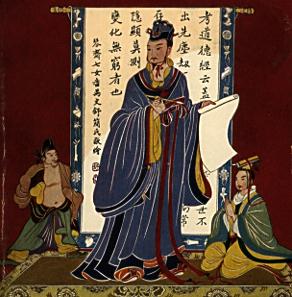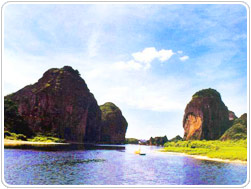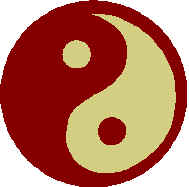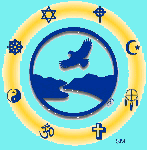|
The Taoist Spiritual Tradition
Taoism (Daoism)
Historical Perspective
Many names describe the Tao or Dao, the
Great Principle or The Way; it eludes intellectual
description because it deals with the big, big picture of life
and energy.
Lao Tzu was the author of the Chinese
book of wisdom, the Tao Te Ching. He and the Tao Te Ching are
intimately involved with the philosophy and religion of
Taoism. The book, which was dictated to a man named Yin Xi in
the 6th Century B.C., is an ancient text that is the
expression of the Tao, dealing with the origins of life,
energy, human nature, society and relationships.
The influence of the Tao on human
culture, medicine, and spiritual beliefs is extensive over the
last 3,000 years. Perhaps like the Tao itself, Lao Tzu’s
influence is as understated as it is pervasive in our lives up
to the present day. Lao Tzu is said to have influenced
Confucius and other Chinese philosophers as well as Zen
Buddhists (the branch of Buddhism that originated in
China).
Taoism is linked to shamanism, the
development of traditional Chinese medicine (TCM) and to the
moving meditations of Qigong and tai chi. In Taoist lore, long
before Lao Tzu, (2700 B.C., Huang Ti (the Yellow Emperor)
created the longevity practices which became Qigong and began
the development of Taoist ways of living. The book Yellow
Emperor’s Classic of Medicine is the first written account
of the concept of Qi (chi) or life force energy. With the rise
of holistic medicine, meditation, Qigong and tai chi in the
Western world, Taoist principles and practices are widely
experienced and embraced in the present day.
Beliefs: What Taoists Believe
The goal of everyone is to become one with the Tao. Taoists
believe that people are by nature, good, and that one should
be kind to others simply because such treatment will probably
be reciprocated.
Qi or Chi is the vital energy of the Universe from which the
world was created. It exists in all living things. The source
of chi has a cosmic origin and is elusive and mysterious, but
its manifestations are real and can be practically applied in
such Taoist disciplines as Qigong and martial arts. The
purpose of Taoism is to release the confusion of society and
bring individuals closer to Nature (the natural flow).
.
Lao Tzu
Principles of Taoism
The principles of Taoism are based on the ancient polarities
of Yin &Yang and Wu Wei. This pair of complementary
opposites creates the flow of nature. Yin is the negative
balance, and has qualities such as femininity, mystery,
relaxation, etc. Yang is the positive balance and has
qualities such as masculinity, heat, aggressiveness, etc.
These forces are always at work together; they keep the
universe vital and alive. They are the agents that actually
produce the mysterious flow of life.

LongHu
Non-physical beings
According to Taoist belief, the world is full of non-physical
beings or spirits who need to obtain energy (feed) to survive.
Some of these spirits must get their energy from humans.
Taoist Diagrams are used to protect individuals’ health,
wellbeing, homes and relationships from the influence of
certain non-physical beings. Diagrams are brush strokes
conforming to specific configurations that modify a person’s
aura.
Taoist Practices
Individuals create a link to the source of Qi or the Great
Ultimate by using images of the Gods and the Spirits in
meditation and ceremonies. These connections bring persons
closer to the Great Ultimate to help them clarify and
straighten their path in life.
The effect of this connection makes an individual mentally
stronger, less confused and able to rectify mistakes of the
past with a clear understand if the Reality of life. The
stronger the connection between the individual and the Great
Ultimate, this Absolute Reality, the clearer is the picture of
the world and the person’s place in it.

Dragon-Tiger Mountain: Birthplace of Taoism in China
Tao Quotes***
What we mean by Tao is the way or course of Nature. This way
has nothing good or bad, it is a mere flowing of things
following the development and decline attributes of the
moment. (From Jhian Yang: A Short Introductory Lesson to Tao
and Taoism)
***
Reading the Tao Te Ching and other Taoist texts felt like
"someone was looking over my shoulder," explaining
to me things that really had relevance to my life. The most
appealing aspect of Taoism, though, was that it didn't claim
to be "divinely-inspired." Laozi never claimed to
have been visited by a deity and commanded to write the Tao Te
Ching. He wrote it because he observed patterns in the world
around him -- patterns that didn't require blind faith and
acceptance of logical contradiction to recognize -- and
realized that everything must be connected somehow.
(From: www.westernreformtaoism.org/introduction.php
).
Symbol of Taoism

The symbol of Taoism is called the 'Tai
Ji' which means the 'great ultimate'. It is represented by a
circle which is divided into two parts. The dark side is
called Yin while the dark side is called Yang. The small
circles suggest that each half has a 'seed' of the other half.
To Taoists, Yin and Yang are not opposites. In fact, each must
exist with the other and cannot exist without the presence of
the other. The impact of human civilization is believed to
upset the balance of Yin and Yang.

Tao
Non-Action
Wu Wei means "non-action" and
is the practice of doing nothing to accomplish everything.
Someone who understands and adheres to Wu Wei does not try to
force things. The way can only be found in humility, in serene
acceptance of life and things as they are, and in finding the
flow of nature, rather than trying to produce and form people
and situations to your own desires.
The Tao Te Ching illustrates: The more
laws you make, the more thieves there will be. (Chapter 57)
The sage does not boast, therefore is
given credit. (Chapter 22)
He who acts harms, he who grabs lets
slip. (Chapter 64)
Technique
Meditate on the dual symbol, the
Ying/Yang.
-Tune into the Yang energy--the masculine dynamic energy of
force and expansion and ask for further insights into this
energy and how you use it in your life.
-Now tune into the white section of the symbol--the Ying
energy. This receptive, nurturing energy, is where creativity
starts. Ask for further insights into this energy and how you
use it in your life.
-Now meditate on the flow of energy back and forth from Yang to
Ying, etc. How is this flow manifesting in your life?
-Share your insights with others.
Further
Learning
Art
Institute of Chicago Philosophical
Taoism
Tao
Page Taoism
info
|
